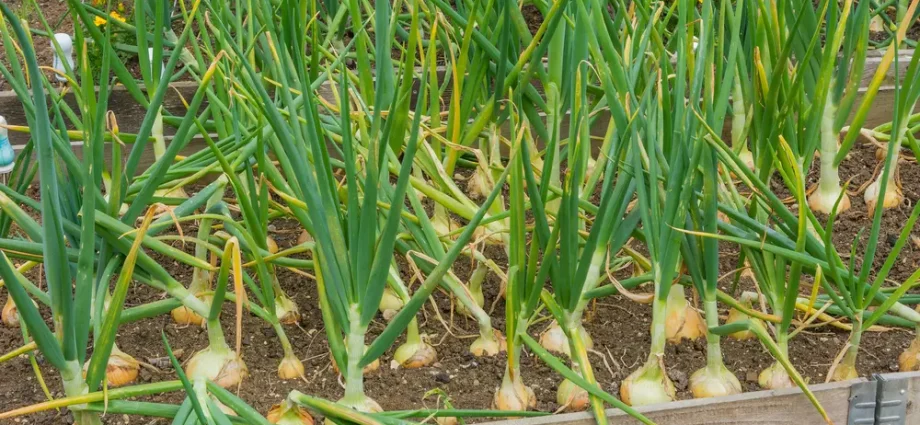Contents
In recent years, forgotten methods of growing vegetables have regained popularity among gardeners. One of them is winter onion. Planting onions before winter allows you to get a rich harvest of full-fledged onions one or two months ahead of schedule, and greens in early spring. The low cost of the method is also attractive – small, defective specimens of onion sets are selected for planting, which will not withstand long winter storage. But it is important to know how to plant and when to harvest Winter Onions.
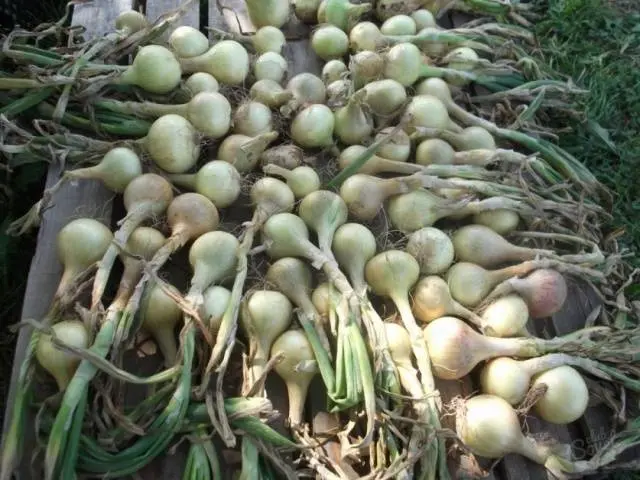
The winter onion is also convenient in that the onion fly does not have time to hit it, since by the time it appears, it builds up a strong root system. And after harvesting, you can once again use the beds, sowing them with other crops. Tomatoes, carrots, eggplants are best suited for this.
Planting material
The smallest onion sets are selected for planting. It is he who has the properties necessary for growing a good crop of winter onions:
- if the bulbs are large, they will begin to shoot, and in small ones there will not be enough nutrients for this;
- during the winter months, the bulbs will receive nutrition from the soil, and in early spring they will begin to form a turnip;
- small onions are defective material, they will not survive storage until spring and will dry out over the winter.
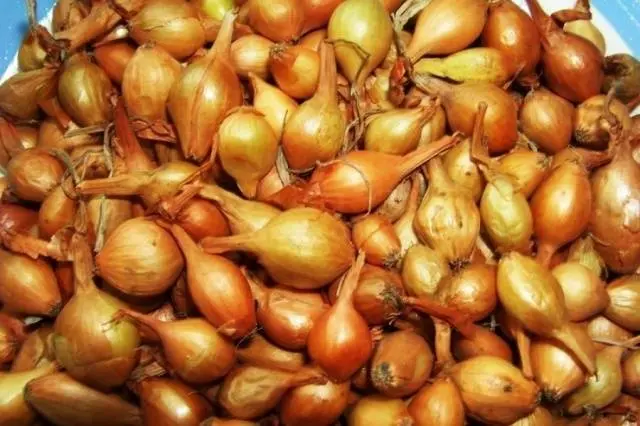
Small onion sets as planting material become very expensive by autumn. Therefore, it is much easier to grow it yourself. Sowing is carried out in early spring, on the first sunny days, when the earth begins to warm up:
- grooves are prepared one and a half to two deep and a few centimeters wide, between which a distance should be left for convenient weeding;
- the grooves are densely sown with chernushka – onion seeds, covered with earth and slightly trampled down;
- on top it is better to mulch with humus;
- if the weather is dry, you need to monitor the timely watering of the growing onion sets and loosening the soil;
- it is not necessary to feed the seeds;
- when you dig up onions, they will show yellowed leaves that have fallen to the ground.
Dug out onion sets should be left in the garden to dry. Then you should peel off the dry leaves and sort the bulbs:
- larger ones, with a diameter of more than 1 cm, will go for spring planting – they must be stored in a dark and cool place;
- those that are smaller than this size are just right for landing before winter;
- bulbs with a diameter of more than two centimeters will go to food.
Planting and growing winter onions
It is good to use beds for planting winter onions, on which cabbage, tomatoes, beans or peas, cucumbers, corn or mustard grew before. After them, the beds can not be fertilized.
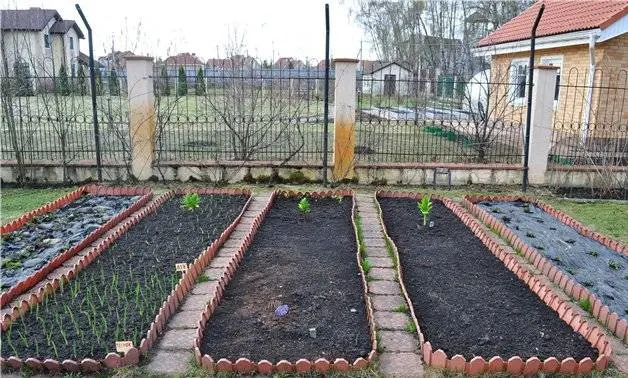
It is difficult to choose the right moment for planting winter onions. Optimal conditions are quite low and, at the same time, positive temperature within 4-6 degrees. Winter onions should have time to take root, but not grow. It is planted in dry weather in shallow grooves up to 5 cm, located at a distance of one and a half dozen centimeters from each other. There should be a gap of several centimeters in the grooves between the bulbs.

After planting, the beds are covered with soil, and on top – with humus mixed with a small amount of sand. Then the beds are mulched with fallen leaves, straw, tops. Experienced gardeners do not recommend using peat as mulch. Due to the low thermal conductivity in the spring, it will inhibit the development of young onion sprouts.
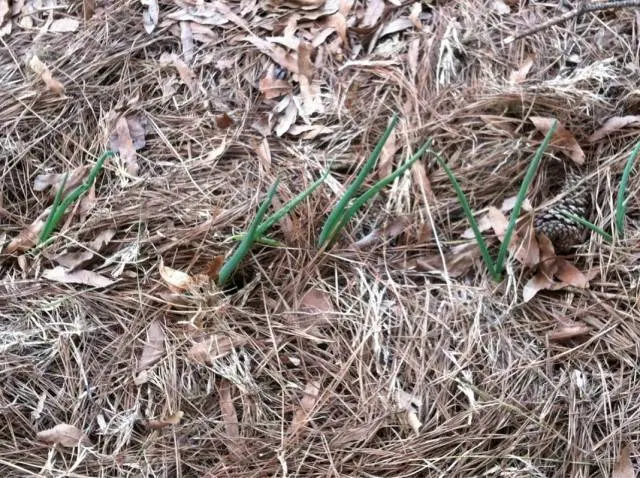
It must be remembered that not every variety is suitable for winter planting. You need to choose cold-resistant and early-ripening, forming a bulb with a short light day. Usually gardeners prefer to plant Dutch varieties before winter. They allow you to shorten the period when you can dig up onions planted before winter.
In spring, winter onions do not require special care. It is enough to remove the mulch to facilitate the warming of the soil and its growth, as well as gently loosen the soil and remove weeds. The frequency of loosening depends on the density of the soil. To accelerate growth, you can cover the beds with a film at night. Useful top dressing infusion of bird droppings. To repel pests, it is recommended to sprinkle the beds with ash, it also contains the necessary minerals and is an excellent fertilizer. As the winter onion grows, it is necessary to thin it out – small and weak sprouts will be eaten as green vitamins, and strong sprouts will receive additional space for growth.

Watering requires special attention:
- in early spring, when the earth is full of moisture from melting snow, winter onions do not need to be watered;
- after the soil dries, regular watering is required to form a good turnip;
- when the bulbs begin to ripen, watering must be stopped, otherwise the crop will not be stored for a long time.
Harvesting winter onions
In order for the crop to be well stored, it is necessary to correctly calculate the time when to harvest winter onions. Gardeners independently determine the time for harvesting winter onions according to the degree of maturity of the plants. Harvesting should be done when the leaves of the plants begin to turn yellow and lie on the ground, and the surface of the bulb is covered with dry scales. A mature bulb is easily removed from the ground. If the soil is too hard, you can carefully dig them with a pitchfork, lifting the soil a short distance from the roots. For 10-14 days, you need to stop watering the beds.
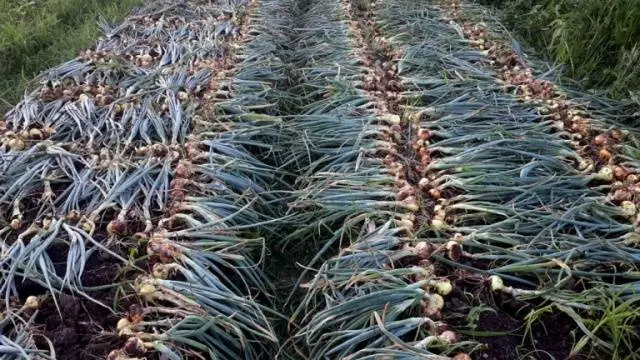
Sometimes, to speed up the ripening of winter onions, their feathers are cut off, leaving a small tail of a few centimeters. However, this method can lead to the onset of decay processes, so it is undesirable to use it.
Cleaning dates may be shifted in one direction or another depending on:
- from the climatic features of the region – the colder the climate, the longer the period of growing winter onions;
- from timely loosening and fertilizing, which accelerate the ripening of the crop;
- from the weather conditions of the current season – a cold and rainy summer lengthens the ripening period of plants;
- on soil quality.
The crop should be harvested in dry sunny weather. It must not be overexposed in the ground, otherwise it will begin to take root again, and such a bow is poorly stored. Not all plants ripen on the same day, so onion harvesting is delayed for several days. However, if it is not possible to dig up the onions gradually, then you can harvest the entire crop in one day, when the main part of it is already ripe.
Drying the harvest
The harvested crop of winter onions must be properly dried so that it is well stored:
- after harvesting, the onions are left in the beds for a day or two to dry;
- at the same time it is disinfected with ultraviolet rays;
- it is impossible to clean the bulbs from adhering earth by mechanical tapping on hard objects, so as not to damage them. In rainy weather, you can dry onions in the attic or under a canopy;
- during drying, you need to regularly mix and turn the bulbs;
- the condition of the neck of the bulb will help determine the end of drying – it will become completely dry, and the scales will easily peel off;
- if there are specimens with a dense, wet neck, they should not be stored, but rather eaten.
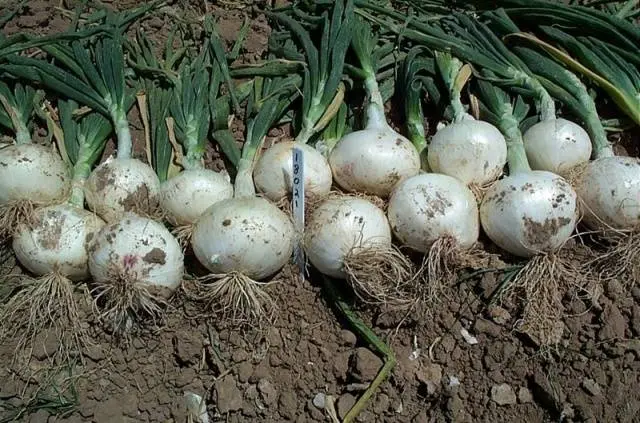
If the onion was harvested on rainy days and the crop got wet, you need to choose a well-ventilated place to dry it, otherwise rotting processes will begin in it.
Winter onion storage
Dried onions can be stored in different ways:
- having cut off the neck, you can put the whole bow in nets or stockings and hang it in the basement;
- cut bulbs can be stored in a wooden box – in this case, you need to stir them from time to time to ensure uniform access of oxygen;
- it is possible, without cutting the necks, to braid the braids and hang them up – this method is convenient in that sprouting bulbs will immediately become noticeable;
- with all storage methods, it is necessary to ensure optimal conditions – temperature from plus one to minus three degrees and humidity not higher than 80%;
- for the preservation of the onion, it is also necessary to provide it with air access, therefore it is unacceptable to store it in plastic bags.

Due to the simplicity and cheapness of the method, the cultivation of winter onions is becoming increasingly popular. If you use special winter varieties for planting before winter, then you can get higher yields of this tasty and healthy vegetable.










